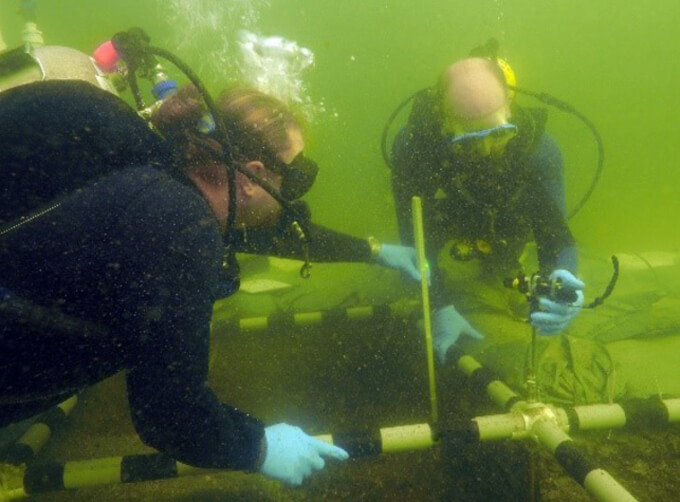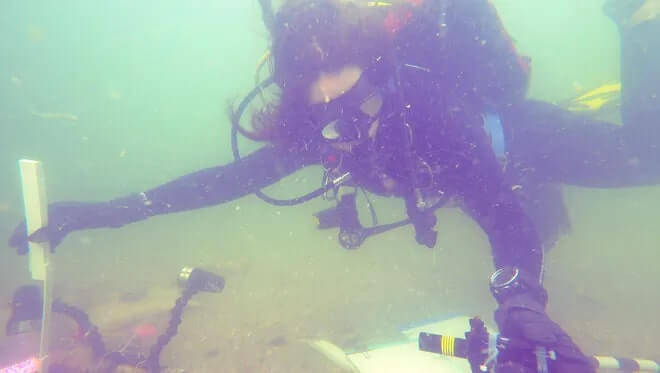Mysterious 7,000-Year-Old Burial Site Discovered In Gulf Of Mexico
A 7,000-year-old burial site in the Gulf of Mexico has recently been found, after a hint from a recreational diver who previously discovered skeletal remnants there, back in 2016.
The site, dubbed “Manasota Key Offshore”, is seemingly conserved in what was back then a freshwater peat pond, and is located off of Sarasota County, Southwest Florida.
This finding is indicated as ‘unprecedented’, though there have been other locations that predate this one by thousands of years.
Duggins said that due to the Gulf of Mexico’s sandy bottom, and as sand doesn’t allow organic material to persist for long, he and other researchers have always believed that there would not be any conserved sites down here. However, this site is constituted mostly of peat soils.
"I was always kind of told that a site like this wouldn’t exist in the Gulf of Mexico, that it wouldn’t be able to survive," Duggins said. "Just out of sheer luck, a citizen brought this information to our attention and it’s been a great experience."
After the discovery, the site, located 300 yards off Manasota Key, has been patrolled by law enforcement officers, together with volunteers, to ensure that no divers would come too close to it.
"It looks like it was almost put there yesterday," Duggins said. "We’ve recovered sticks that are sharpened on the end, they have marks on them and you can see charring, and normally wood is the first thing that goes. It disintegrates."
So far, the oldest site to have been found is in the Big Bend area, dating back 14,500 years. Meanwhile, the Manasota site is about three-quarters of an acre in size and was located along the shoreline.
After conducting carbon dating analysis, researchers were able to determine the age of the carved stakes, around 7,214 years ago. At the time, sea levels were much lower, and the peat-bottom pond allowed the exceptional preservation of the remnants at the site.
"In all of the work that I do, I never lose track of the fact that I am handling materials that are of special importance to families and groups, especially those of the Miccosukee and Seminole tribes of Florida," said Heather Walsh-Haney, an FGCU forensics professor.
Local authorities have decided not to reveal the exact location of the site to the public, in order to preserve its sensitive nature. Specifically, it is under protection by Florida law, in which any attempts to disturb the site or remove anything from it is considered against the law.
Lastly, Ryan Duggins stated that he wants to survey around the areas surrounding Venice and off Charlotte County to find out whether the burial site at Manasota is part of a larger ancient community able to provide more evidence of life 7 millennia ago.
"I’m very confident that Florida’s continental shelf holds a lot more archaeological material that can be found," Duggins said. "I would definitely like to have a more concerted effort around Sarasota and Venice."
H/T: News-Press
The site, dubbed “Manasota Key Offshore”, is seemingly conserved in what was back then a freshwater peat pond, and is located off of Sarasota County, Southwest Florida.
This finding is indicated as ‘unprecedented’, though there have been other locations that predate this one by thousands of years.
 Source: Florida Department of State
Source: Florida Department of State
Duggins said that due to the Gulf of Mexico’s sandy bottom, and as sand doesn’t allow organic material to persist for long, he and other researchers have always believed that there would not be any conserved sites down here. However, this site is constituted mostly of peat soils.
"I was always kind of told that a site like this wouldn’t exist in the Gulf of Mexico, that it wouldn’t be able to survive," Duggins said. "Just out of sheer luck, a citizen brought this information to our attention and it’s been a great experience."
After the discovery, the site, located 300 yards off Manasota Key, has been patrolled by law enforcement officers, together with volunteers, to ensure that no divers would come too close to it.
 Source: Florida Department of State
Source: Florida Department of State
"It looks like it was almost put there yesterday," Duggins said. "We’ve recovered sticks that are sharpened on the end, they have marks on them and you can see charring, and normally wood is the first thing that goes. It disintegrates."
So far, the oldest site to have been found is in the Big Bend area, dating back 14,500 years. Meanwhile, the Manasota site is about three-quarters of an acre in size and was located along the shoreline.
After conducting carbon dating analysis, researchers were able to determine the age of the carved stakes, around 7,214 years ago. At the time, sea levels were much lower, and the peat-bottom pond allowed the exceptional preservation of the remnants at the site.
 Source: Florida Department of State
Source: Florida Department of State
"In all of the work that I do, I never lose track of the fact that I am handling materials that are of special importance to families and groups, especially those of the Miccosukee and Seminole tribes of Florida," said Heather Walsh-Haney, an FGCU forensics professor.
Local authorities have decided not to reveal the exact location of the site to the public, in order to preserve its sensitive nature. Specifically, it is under protection by Florida law, in which any attempts to disturb the site or remove anything from it is considered against the law.
 Source: Florida Department of State
Source: Florida Department of State
Lastly, Ryan Duggins stated that he wants to survey around the areas surrounding Venice and off Charlotte County to find out whether the burial site at Manasota is part of a larger ancient community able to provide more evidence of life 7 millennia ago.
"I’m very confident that Florida’s continental shelf holds a lot more archaeological material that can be found," Duggins said. "I would definitely like to have a more concerted effort around Sarasota and Venice."
H/T: News-Press
Share this article
Advertisement